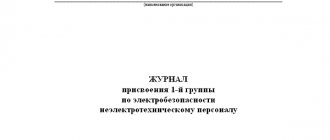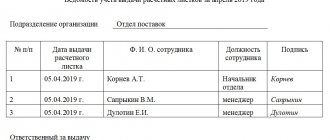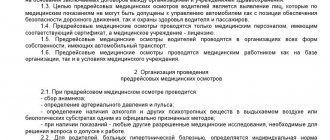What kind of occupational safety magazines are there?
The legislation of the Russian Federation in the field of labor protection (Labor Code of the Russian Federation, GOST 12.0.004-90, Decree of the Ministry of Labor of the Russian Federation dated December 17, 2002 No. 80) requires Russian employers to keep logs:
- registration of introductory briefings on labor protection (clause 7.1.5 GOST 12.0.004-90);
- registration of labor safety briefings that are not introductory (clause 7.9 of GOST 12.0.004-90);
- taking into account instructions on labor protection (clause 5.10 of the appendix to the resolution of the Ministry of Labor of the Russian Federation dated December 17, 2002 No. 80);
- accounting for the issuance of instructions on labor protection (clause 5.10 of the appendix to the resolution of the Ministry of Labor of the Russian Federation dated December 17, 2002 No. 80);
- registration of accidents (Article 230.1 of the Labor Code of the Russian Federation).
These registers are the main journals on labor protection at Russian enterprises.
We will prepare for you a complete list of labor protection documents that an employer must have
“Type of briefing (primary, repeated, unscheduled, targeted)” (column No. 5).
at least once every six months (in fact, we repeat the initial briefing at the workplace), unless other deadlines and frequency are specified by industry and cross-industry regulatory legal acts that apply to the activities of your organization. For example, driver Ivanov I.I. undergoes repeated instruction once every 3 months (clause 10.10 of the Resolution of the Ministry of Labor of the Russian Federation of May 12, 2003 N 28 “On approval of Inter-industry rules for labor protection in road transport”). Regulate the frequency of repeated briefings by order of the organization (for example, in the same order “On conducting briefings on labor protection”). At the same time, if some of the employees of one division must undergo training once a quarter, and another part - once every six months, you can establish repeated instructions once a quarter for all employees of this division, since this does not contradict the current legislation and will allow the person responsible for Conducting briefings for this unit will not cause confusion.
when performing one-time work, when eliminating the consequences of accidents, natural disasters and work for which a permit, permit or other special documents are issued, as well as when holding mass events in the organization.
“The reason for conducting an unscheduled, targeted briefing” (column No. 6).
Possible reasons listed in clauses 7.4.1, 7.5.1 of GOST 12.0.004-90. Interstate standard. System of occupational safety standards. Organization of occupational safety training. General provisions”, paragraphs 2.1.6-2.1.7 of the Resolution of the Ministry of Labor of the Russian Federation, the Ministry of Education of the Russian Federation dated January 13, 2003 N 1/29 “On approval of the Procedure for training in labor protection and testing knowledge of labor protection requirements for employees of organizations”, we have already indicated in the table above, they can be briefly formulated as follows:
| Briefing | When do we do it? |
| primary | before the start of production activities, after the employee has received introductory instructions on labor protection. |
| repeated | |
| unscheduled |
|
| target |
| unscheduled | “introduction of new instructions on labor protection”, “change in technology”, “replacement of equipment”, “violation of labor protection requirements”, “accident”, “Act No. on an industrial accident”, “work interruption”, etc. . |
| target | “accident response”, “territory cleaning”, “work at height”, “welding work”, etc. |
“Information about on-the-job internships” (Columns No. 11-13). The employer is obliged to conduct an internship for employees entering work with harmful and (or) dangerous working conditions (Article 225 of the Labor Code of the Russian Federation), and the requirement for an internship may be contained in regulatory legal acts in the field of labor protection. The employer determines the duration of internship shifts independently (from 2 up to 14 shifts), based on the qualifications and work experience of the employee, the nature of the work performed. It is worth noting that in addition to an entry in the Journal for the internship, you also need: an internship program, an order for the employee’s internship, an order for the admission of this employee to independent work (if successful completion of the internship), a local regulatory legal act that contains the procedure for the internship, the features of conducting the internship in your organization.
Who is responsible for maintaining labor safety logs?
By separate orders of the company management, those responsible for maintaining:
- both types of briefing logs;
- accident register.
The competence of persons appointed by management to be responsible for maintaining these labor safety logs includes:
- timely entry of necessary information into them;
- prompt provision of occupational safety journals for use by other specialists, as well as their subsequent acceptance back for storage.
Regarding log books and issuing instructions, management can also appoint an employee responsible for maintaining and storing them. If the document is developed for a specific structural unit of the company, its storage should be carried out by the head of this unit.
Who leads and fills out
Large enterprises usually have an entire department that deals with occupational safety issues. But, even if there is no such structural unit, the functions of conducting safety training can be assigned to almost any employee. Before doing this, he will have to be sent for training. After this, the employee will receive a certificate (diploma, certificate) and the right to conduct training.
The head of the department is obliged to monitor the work of the responsible employee and check the log at least once a month. The head of the enterprise must do this at least once a quarter.
It is recommended that after each inspection, the controlling official makes a note indicating the presence or absence of violations in the maintenance of TB logs.
If a legal entity is engaged in activities that involve dangerous and/or harmful working conditions, then for each of these areas there must be an employee who has been trained and knows how to act in certain conditions. It is these employees who have the right to conduct instructions.
Specifics of filling out occupational safety logs
Now let’s look at what nuances an employer should pay attention to when filling out occupational safety logs.
For both types of training logs, it is important to pay attention to:
- the presence of signatures of the person being instructed and the person instructing opposite each entry on the instruction;
- indication of the full name and positions of the instructed employee and instructor, the date of each briefing.
To fill out the instruction logbook, the following are of greatest importance:
- correct indication of the date of registration of the instruction and the beginning of its use;
- correct title of documents;
- presence of signatures of the responsible employee confirming the fact of acceptance of the instructions for registration.
With regard to the instruction log, special attention should be paid to:
- correct indication of the date of issue of instructions upon request;
- indication of the full name of the employees receiving instructions, as well as the presence of their signatures.
When filling out the accident log, it is important to indicate:
- the exact date, time, location of the incident;
- all necessary information about the victim;
- measures taken to eliminate the causes of the accident.
These nuances of filling out occupational safety logs are among the most critical. This does not mean that other columns or paragraphs of the document need not be filled out at all. It is also necessary to work with them, but errors or omissions of entries in them may not be as critical as in the elements of occupational safety journals reflected above.
INTRODUCTION REGISTRATION LOG
Logbook for issuing labor safety instructions
JOURNAL OF REGISTRATION OF INSTRUCTIONS AT THE WORKPLACE
JOURNAL of recording instructions on labor protection for workers
JOURNAL of registration of accidents at work
Fire safety briefing log
One of the most important parts of an enterprise’s fire safety policy is training personnel in the rules of behavior to exclude or eliminate fire hazardous situations. Information about the training conducted is recorded in a separate fire safety briefing log.
Correctly filling out training logs
Attention
The completion of the briefing must be recorded in a log, which is confirmed by the signatures of the person being instructed and the person conducting the briefing. Unscheduled briefing should be carried out: when new or revised standards, rules, instructions, as well as changes to them; when changing the technological process, replacing or upgrading equipment, devices and tools, raw materials, materials and other factors affecting labor safety; in case of violation by employees of labor safety requirements, which can lead to injury or occupational disease, emergency situations; at the request of supervisory authorities; during breaks in work (30 and 60 days).
Unscheduled briefings are carried out directly by the work manager.
Why do you need a fire safety training log in the workplace?
Mastering the theoretical part of safety precautions at an enterprise is a prerequisite for admitting a newly arrived employee to his workplace. In addition to introductory training, other types of classes are provided for employees, depending on their length of service at the enterprise or other special conditions. There are a total of 5 types of training for staff:
- - introductory;
- - primary;
- - repeated;
- — target;
- - planned.
It is unacceptable to treat filling out the instruction registration book as a mere formality. Indeed, in the event of an emergency at the enterprise, it will confirm that training sessions were conducted with employees. And any inspection by the fire department will first require a log.
The manager or person responsible for safety is responsible for the timeliness and correctness of filling out the log. The authorized employee must have perfect knowledge of the discipline being taught and have experience working at the enterprise in question. In addition, he is required to have personal qualities that will help ensure a safe environment in the enterprise.
Important! Often, upon arrival to a new position, an employee undergoes simultaneously training in fire safety and labor protection. In such a situation, appropriate entries in separate journals are necessary.
Required details
The safety log (a sample is given below) must necessarily contain the following columns:
- serial number;
- FULL NAME. employee undergoing training;
- Date of Birth;
- employee position, structural unit;
- type of instruction;
- the reason for which the briefing is being conducted (to be filled in if it is unscheduled);
- FULL NAME. the employee responsible for conducting the training;
- signatures of the official conducting the instruction and the person being instructed.
The TB journal can be supplemented with information about the internship: how many days, the result of the training, after the internship.
Fire safety induction log form
To ensure that the responsible employee does not have problems with the inspection authorities, it is important to learn how to fill out the logbook for the introductory fire safety briefing.
Traditionally, each page of such a book contains a table with columns:
- — Date of instruction;
- — Full name of the employee who attended the instruction;
- — year of birth of the person being instructed;
- — the position of the listener;
- — type of instruction;
- — Full name of the instructor;
- — signatures of participants.
- Before you start filling out the log, it is important to make sure that it meets the following requirements:
- Convenient firmware. The sheets must be stitched with thin lace or thread. It is important to make sure that all pages open comfortably and that the text is completely readable.
- Seal. After stitching the book, the ends of the lace are glued to the cover along with a special sticker. It indicates the number of sheets in the magazine, the lacing date and information about the responsible employee. After the glue has dried, a stamp is placed on the sticker and part of the cover.
- Numbering. Page counting can start from the cover or from the first page with a table. For numbering, a pen, a stamp, or a printout can be used. The main thing is that the page numbers are indicated before using the book.
Rules for filling out the logbook for fire safety briefings
The legislation establishes strict standards for filling out and maintaining current logs, as well as storing archival documents.
When filling out the pages of the journal, it is prohibited:
What to do if you lose a document
What to do if the magazine is lost
Anything can happen in production and it is possible that the Journal may be lost. What needs to be done to eliminate possible problems?
Algorithm of actions:
- If the document is lost, then it is necessary to report this fact to the manager and the safety specialist.
- Prepare an administrative document for the restoration of the Journal, indicating the reason. Create a commission and prepare a free-form Act, which is signed by the members of the commission and approved by the chairman.
- The order or instruction regarding the loss, together with the Certificate, shall be handed over for storage to the person appointed responsible for record keeping.
- Create a new Journal, which should initially be stitched, numbered, and then filled out. Moreover, the date of the briefing must be entered as fresh, and there is no need to restore previous records.









